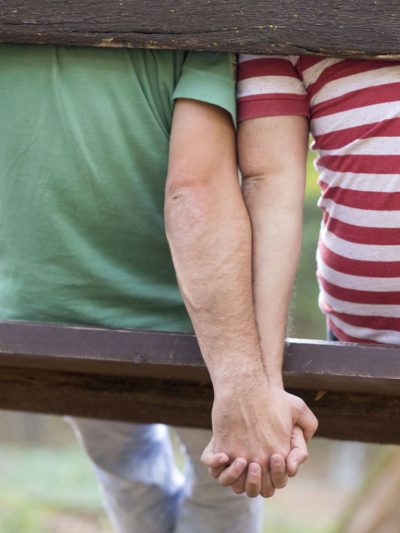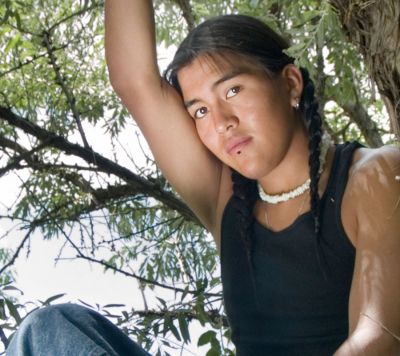LGBTQ2s+
Creating welcoming, affirming and inclusive community, school, home and health care environments for lesbian, gay, bisexual, transgender, queer or questioning and two-spirit (LGBTQ2S+) youth makes spaces safer for everyone.

About 2-10% of North Americans identify as LGBTQ2S+.1
A growing body of research demonstrates that LGBTQ2S+ youth in supportive, inclusive and safer environments maintain a high level of physical, emotional, academic and social health.
In the absence of these affirming environments, LGBTQ2S+ youth face a number of increased social, mental health, educational and physical concerns. It is not being LGBTQ2S+ that increases these risks. Rather, it is the lived experience of stigma, discrimination, isolation and prejudice that result in these challenges.
LGBTQ2S+ youth are more likely to:1,2,3,4
- have mental health concerns like depression and suicide attempts
- have problematic substance us, use illegal drugs
- have high-risk sexual encounters, contract HIV and sexually transmitted infections (STIs)
- experience interpersonal violence like assault, dating violence, sexual assault, bullying and discrimination
- be street involved or homeless
Sexual and Gender Diversity
Sexual and gender diversity are broad terms that include all of the ways a person’s sexuality is uniquely their own including assigned sex, reproductive biology, sexual orientation, gender identity and gender expression.
These broad terms are sometimes expressed as acronyms like:
-
LGGBTTTQQAAAIP – lesbian, gay, gender queer, bisexual, transsexual, transgender, Two-Spirit, queer, questioning, asexual, ally, androgynous, intersex, pansexual
-
LGBT or GLBT – lesbian, gay, bisexual, transgender
-
LGBTQ+ – lesbian, gay, bisexual, transgender, queer and other identities not listed
-
LGBTQ2S+ – lesbian, gay, bisexual, transgender, queer, Two-Spirit and other identities not listed
-
SOGIE – sexual orientation and gender identity and expression
When people are talking about sexual and gender diversity, they are talking about:
- Sex: categories (male, female) to which people are typically assigned at birth based on physical sex characteristics. This is also called assigned sex or sex assigned at birth. This label typically appears on proof of identity documents, unless a person has documentation changed. People may also be intersex.
- Sexual orientation: a person’s emotional and/or sexual attraction to others. It can be fluid and may or may not reflect sexual behaviors. Sexual orientation and gender identity are not the same thing.
- Gender/gender identity: a person’s internal sense of identity as female, male, both, or neither, regardless of sex assigned at birth. It is not visible to others.
- Gender expression: External and public presentation of a person’s gender. This can include appearance, name, and pronouns. If a person is cisgender, it means their identity conforms to the cultural expectations of their assigned sex. If a person is transgender, it means that their identity differs from the cultural expectations of the sex they were assigned at birth.
Terms
It can be helpful to have a basic understanding of terms related to sexual and gender diversity. This can support people to use inclusive language and better meet the needs of LGBTQ2S+ children, youth and families.
Language is fluid. Some terms may have a negative meaning for some people and other terms go out of favour. Terms change and new terms become more accepted. Some words, like “queer” have been reclaimed by some members of the LGBTQ2S+ community; others find these words hurtful and offensive. Some words that were once commonly used, like “homosexual” or “hermaphrodite” are now generally considered offensive.
Definitions of commonly used terms:5
Scroll mouse over each term for more information.
AGENDER
AGENDER
A person who does not identify with a specific gender or have recognizable gender expression.
ASEXUAL
ASEXUAL
A person who does not experience sexual attraction; may or may not experience emotional/romantic attraction.
ALLY
ALLY
A person who advocates for human, civil and sexual rights for sexual minorities and who challenges discrimination and heterosexism.
BISEXUAL
BISEXUAL
A person who has emotional and/or sexual attraction to people of any gender or sex; also a person who has sexual attraction to males and females.
CISGENDER/CIS
CISGENDER/CIS
A person whose identity conforms to the cultural expectations of the sex assigned at birth.
GAY
GAY
A person who has emotional or sexual attraction to people of the same sex or gender. Often used for a male who has emotional or sexual attraction to males.
GENDER BINARY
GENDER BINARY
This is the classification of sex and gender into two distinct and disconnected states of masculine and feminine. It describes a social boundary that discourages people from crossing or mixing gender roles.
GENDER
GENDER
Social and cultural expectations of roles and presentations.
GENDER IDENTITY
GENDER IDENTITY
A person’s internal sense of identity as female, male, both or something else, regardless of sex assigned at birth.
GENDER EXPRESSION
GENDER EXPRESSION
How a person presents their gender. This can include appearance, name, pronoun, behaviour, voice or body characteristics.
GENDER FLUID
GENDER FLUID
The gender identity, behaviors and appearance of a person moves along a gender spectrum and/or challenges gender restrictions and norms. Related terms can include gender queer, gender non-conforming, gender neutral, pangender, tri-gender, agender, non-binary gender, or gender independent.
HETEROSEXISM
HETEROSEXISM
Discrimination based on the assumption that all people are heterosexual and cisgender and that these are the normal and/or superior sexual orientation and gender identities.
HETEROSEXUAL (STRAIGHT)
HETEROSEXUAL (STRAIGHT)
A self- identifying term for someone who is physically and/or emotionally attracted to people of the opposite sex or gender, to their own.
HOMOSEXUAL
HOMOSEXUAL
A dated and potentially offensive term for a person who has emotional and/or sexual attraction to people of the same sex.
HOMO/BI/TRANS PHOBIA
HOMO/BI/TRANS PHOBIA
A fear and/or hatred of homosexuality/bisexuality/transgender shown by prejudice, discrimination or acts of violence.
INTERSEX
INTERSEX
A person’s reproductive, sexual or genetic biology is unclear, not exclusively male or female or otherwise does not fit with traditional definitions of male or female.
LESBIAN
LESBIAN
A female who has emotional and/or sexual attraction to females.
PANSEXUAL
PANSEXUAL
A person who has emotional and/or sexual attraction to people of any gender or sex.
POLYAMORY
POLYAMORY
Having more than one sexual loving relationship at the same time with consent of all partners involved.
QUEER
QUEER
A reclaimed term used by some people who identify as a sexual minority and also used as a positive collective term to describe communities and social movements.
QUESTIONING
QUESTIONING
A person who is exploring, or is unsure of, their sexual orientation or gender identity.
SEX
SEX
Categories (male, female, intersex) to which people are typically assigned at birth based on reproductive biology and genetics. The term is also used to refer to sexual activity.
SEXUAL ORIENTATION
SEXUAL ORIENTATION
A person’s emotional and sexual attraction to others. It can be fluid and may or may not reflect sexual behaviors.
TRANSGENDER (TRANS, TRANS-IDENTIFIED)
TRANSGENDER (TRANS, TRANS-IDENTIFIED)
An umbrella term for people whose gender identity and/or gender expression do not fit conventional expectations of sex assigned at birth. Not all people identity as transgender and some people may describe themselves using one or more of a wide variety of terms.
TRANSITION
TRANSITION
A process of change that refers to activities that a transgender person may undertake to affirm their gender identity. This may include physical, legal and social changes.
TRANSSEXUAL
TRANSSEXUAL
A transgender person expressing their self-identified gender through transition which could include medical intervention.
TWO-SPIRIT
TWO-SPIRIT
A cultural term used by some Aboriginal people to mean a person has both male and female spirit which may include concepts of spirituality, sexual orientation and gender identity.
Coming Out
Coming out is the process of revealing one’s identity. Recognizing one’s own identity is to come out to oneself. People may also come out to others. When a person comes out, it is important to show supportive behaviors to help build greater well-being and self-esteem and lower risk of mental, social, physical and academic problems. Rejecting behaviors increases risk.
Supportive behaviors create safety and include:
- supporting the youth’s LGBTQ2S+ identity and gender expression
- talking about the youth’s LGBTQ2S+ identity using active listening and encouraging, positive body language
- welcoming the youth’s LGBTQ2S+ friends and partners
- bringing youth to LGBTQ2S+ organizations or events, connecting them with LGBTQ2S+ role models
- advocating for a youth when they are mistreated
- working to make a faith community supportive of LGBTQ2S+ members or find a supportive faith community that welcomes LGBTQ2S+ youth and their families,
- taking actions to be an ally.
Rejecting behaviors, on the other hand, are harmful and may include:
- Expressing disappointment when youth come out,
- Discounting or ignoring LGBTQ2S+ youth,
- Physical or verbal abuse,
- Excluding youth,
- Blocking access to LGBTQ2S+ friends, events and resources,
- Blaming youth if they are discriminated against,
- Pressuring youth to be more or less masculine or feminine, and
- Telling youth that God will punish them because they are LGBTQ2S+.
How to Support LGBTQ Youth
Strategies used to support LGBTQ2S+ youth create safer, more inclusive spaces for everyone.
- Focus on the youth and their needs not their sexual orientation or gender identity.
- Avoid making assumptions about gender, sexual orientation, sexual behaviors/practices, family structures, or relationships.
- Communicate as respectfully about people as you do to people. People recognize when these are not consistent.
- Express willingness to learn about individual needs. Listen to what someone is saying, both in their words and in non-verbal communication.
- Acknowledge and apologize for mistakes and slip-ups without dwelling on the issue.
- Protect the confidentiality of all information. This includes not revealing gender identity or sexual orientation to others, even those who may be present at an appointment or session between the client and service providers.
- Create safer, inclusive spaces. (see below)
- Use inclusive language (see below) and be aware of non-verbal communication such as facial expression, body language and tone of voice.

Creating Safer, Inclusive Spaces
- Provide all-gender bathrooms and change rooms.
- When possible, avoid separating people according to sex. When separation is required, consideration needs to be given to the client’s gender identity.
- Include images of sexually and gender diverse people and families in posters, literature, and resources.
- Create a non-discriminatory policy and code of conduct outlining the expectations and responsibilities of staff and clients.
- Post a non-discriminatory statement that equal service will be provided to all clients regardless of age, sex, race, gender identity, gender expression, sexual orientation and religion.
- Consider displaying LGBTQ2S+ welcoming symbols such as the rainbow flag.

Inclusive Language
When service providers find ways to make their language inclusive, ALL clients and colleagues are recognized and included.
Heterosexist and heteronormative (see definitions) culture is often reflected in even the most common communication. For example:
- Teachers calling their classes to attention by saying “OK boys and girls;” or
- Admission forms asking to identify as either female or male.
It is important to avoid:
- Joking or teasing about biological sex, gender identity or sexual orientation (such as, “you throw like a girl” or “that’s so gay”), or
- Using derogatory slang (such as, homo or tranny).
Using inclusive language strategies, such as those listed below, create safer, more welcoming service.8
| Situation | Strategy |
|---|---|
| When talking with people |
|
| During intake or when meeting client for the first time |
|
| When talking about clients |
|
| When asking about relationships |
|
| If gender or name shown on file doesn’t match youth’s representation |
|
| If a client “comes out” to staff |
|
| If staff makes a mistake or assumption |
|
| When gathering information |
|



